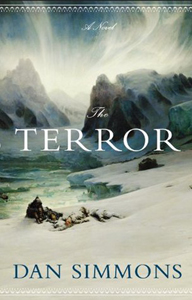Dan Simmons’ “The Terror” (2007) mixes horror and history, fiction and fear. If you’ve seen the 2018 TV miniseries, a lot of the book will be familiar, but it does offer additional details and some things that don’t translate to film.
A good chunk of the novel’s 955 pages evoke an oppressive sense of misery and hopelessness, but in such a masterful way that I admired Simmons’ skill even as my mood became darker from reading the book.
History and speculation
There are also stretches of fascinating history and speculation about the mid-19th century’s lost Franklin expedition to find the final leg of the Northwest Passage. The two British ships, Erebus and Terror, never returned. The shipwrecks weren’t found until a few years after Simmons’ novel (fairly close to where Simmons places them), but a lot of the real history had been pieced together by that point.

“The Terror” (2007)
Author: Dan Simmons
Genre: Historical fiction
Setting: Mid-19th century, northern Cananda
Simmons honors the real history whenever possible, but the day-to-day details are made up. A lot of it comes from Simmons asking “What would happen in this situation, based on naval procedure and protocol, and other accounts of people’s behavior in cold temperatures when running low on food?”
Less mundanely, Simmons dives into Eskimo spiritual beliefs and traditions as “The Terror” takes fantastical turns. We’ve experienced so much real-world horror by that point that the supernatural is a short leap. As surgeon Dr. Goodsir – the most likable of the many point-of-view characters – puts it, it’s hard to believe that Hell could be any worse than what he’s seen on Earth, both from nature and from men.
Perhaps surprisingly, Simmons uses the actual names of the 100-plus men on the expedition. I guess enough time has gone by that there are no relatives around to be offended, but it’s kind of crazy to think, for example, that he makes Cornelius Hickey into the leader of cannibal mutineers when the real-world man by that name might’ve been a perfectly nice guy.
(The TV series, perhaps addressing potential concerns, shows an anonymous boarder stealing the real Hickey’s identity.)
Cannibalism hangs over whole book
Historical findings support the cannibalism theory in general, though, and that notion hangs over the whole book even though it’s only lightly suggested in the early pages. More fantastical horror comes in the form of a monster stalking the crewmen after the ships get frozen solidly in the ice.
Oddly, the monster – an outgrowth of the disputed theory that polar bears are the only animals that actively hunt man – ranks pretty low among “The Terror’s” terrors. After all, being eaten by the snow beast would at least put the sailor out of his misery.
The real-world history and speculation about Arctic geography is an escape for the reader the way rum is an escape for the crewmen. Parts of the presumed Northwest Passage – coming from both the east and the west — had been mapped earlier in the 19th century, and at one point after the ships’ sailing stage, the Terror’s Captain Crozier (the main character) announces that they’ve found the last leg of the passage. (In real history, it wasn’t completely mapped until the early 20th century.)

It’s also fun to learn about geographic speculation from the age before satellite imagery and modern climate knowledge, such as the theory of a great polar continent that could become the home for shipping-lane ports.
The details of the expedition have a “Titanic” vibe in many ways. Reading this book, I’m often reminded of that line in Titanic where we learn there aren’t enough lifeboats because someone thought they made the deck look cluttered.
Nature defeats best-laid plans
Several decisions about the outfitting of the Franklin expedition follow similar types of logic that fall apart once the ships are amid the Arctic ice – not the least of which is the sheer number of men (hundreds) on the expedition. Later, when Crozier sees how the Eskimos survive and even stay toasty warm with minimal possessions, the captain marvels at the excesses and wrongful assumptions of the British expedition.
Fans of the TV series might want to check out the book. Although a lot of it is similar, the ending is richer in detail. The book explains the monster, which remains mysterious in the TV series. Simmons also includes some horrors that would be hard to portray on film, including the problem of trying to find open water but needing to cross thinning ice in order to get to that water. And even then, it might be just a “lake” in the ice, rather than true open water.
In the closing chapters, Simmons ratchets up the supernatural aspect of the beast, and extrapolates that into the notion that humans do not belong in the Arctic. This is a land of gods, not men. All of the problems on the journey have led to this final statement, and it finally clicks why the author would include a monster when nature itself is so horrifying.
“The Terror” steadily ratchets up the misery, yes, but Simmons keeps the historical tidbits and geographical and naval details apace with the multi-pronged horror of the journey. Oddly, despite the fact that this is a best-seller, I wouldn’t recommend it for someone looking to have a good time while reading.
“The Terror” takes us to a place in time and history that’s as “not of this Earth” as possible without leaving the planet. But it’s an intellectually fascinating kind of escapism, not a fun kind.

